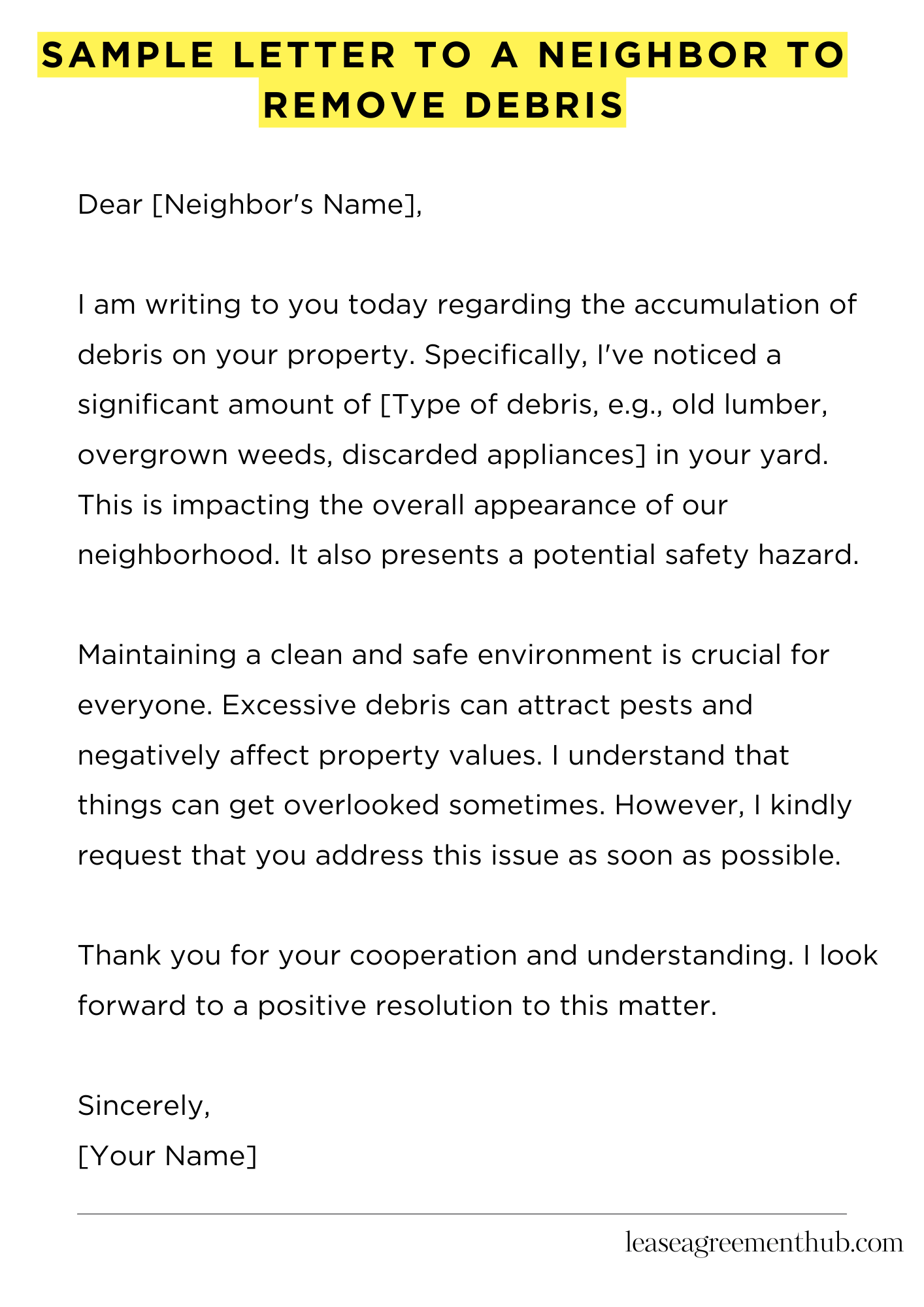Ever wished for an easy way to ask your neighbor to clean up some mess? A sample letter helps you do just that. It politely requests debris removal without causing unnecessary conflict.
This article gives you ready-made letter examples. We provide templates you can easily adapt. You’ll find several options to choose from.
These samples make writing your own letter simple. Save time and effort. Get your point across clearly and respectfully.
Sample Letter to a Neighbor to Remove Debris
[Your Name]
[Your Address]
[Your Phone Number]
[Your Email Address]
[Date]
[Neighbor’s Name]
[Neighbor’s Address]
Dear [Neighbor’s Name],
I am writing to you today regarding the accumulation of debris on your property. Specifically, I’ve noticed a significant amount of [Type of debris, e.g., old lumber, overgrown weeds, discarded appliances] in your yard. This is impacting the overall appearance of our neighborhood. It also presents a potential safety hazard.
Maintaining a clean and safe environment is crucial for everyone. Excessive debris can attract pests and negatively affect property values. I understand that things can get overlooked sometimes. However, I kindly request that you address this issue as soon as possible.
Please remove the debris within [Number] days. If you require assistance, I would be happy to help in any way I can. Perhaps we could work together to clean up the area. We could even share tools.
Thank you for your cooperation and understanding. I look forward to a positive resolution to this matter.
Sincerely,
[Your Name]

How to Write a Sample Letter to a Neighbor to Remove Debris
Understanding the Nuances of Neighborly Disputes
Resolving neighborhood disagreements requires tact and diplomacy. A poorly worded communication can exacerbate the situation, creating further friction. Conversely, a carefully crafted letter can facilitate a peaceful resolution. Remember, your goal isn’t to antagonize, but to elicit cooperation. This necessitates a measured and considerate approach.
Crafting a Salutation: Setting the Tone
Begin with a polite salutation. Avoid overly familiar terms; a simple “Dear [Neighbor’s Name]” suffices. Starting with a formal address sets a respectful tone, crucial for maintaining a civil discourse. This initial formality demonstrates your seriousness without being confrontational.
Articulating the Issue: Clarity is Paramount
Clearly and concisely describe the problem. Specify the location and nature of the debris. Use precise terminology; instead of vaguely mentioning “junk,” be explicit: “accumulated building materials,” “overgrown vegetation,” or ” discarded appliances.” Ambiguity breeds misunderstanding. Provide concrete details. This avoids any potential for misinterpretation.
Explaining the Ramifications: Highlighting Consequences
Subtly highlight the negative consequences of the debris. Mention potential health hazards, aesthetic blight, or violations of homeowner’s association rules, if applicable. This isn’t about blame, but about illustrating the shared impact of the issue. Focus on the collective well-being of the neighborhood.
Proposing a Solution: Offering a Path Forward
Suggest a reasonable solution. Propose a timeframe for removal. A collaborative approach is more effective than a dictatorial one. Perhaps suggest a compromise, or offer assistance if appropriate. Remember, a conciliatory tone can significantly improve the chances of a positive outcome. Avoid ultimatums.
Concluding with Civility: Maintaining Amicability
End with a polite closing, such as “Sincerely” or “Respectfully.” Reiterate your desire for a collaborative resolution. Your closing should reflect the overall tone of the letter – courteous and professional. A positive concluding statement reinforces your intent for amicable resolution. This leaves the door open for continued dialogue.
Review and Refine: Ensuring Effectiveness
Before sending, meticulously review the letter. Ensure it’s free of grammatical errors and maintains a consistently professional tone. A well-written letter projects an image of seriousness and respect. Proofread carefully; minor oversights can undermine your message. Consider having a trusted friend review it before dispatch.
FAQs about sample letter to a neighbor to remove debris
Communicating effectively with neighbors about property maintenance can sometimes be challenging. Here are some frequently asked questions to help guide you in writing a polite and productive letter.
What is the best way to start a letter requesting debris removal?
Begin with a polite and friendly opening, acknowledging your neighbor’s presence and establishing a positive tone. Avoid accusatory language. A good start might be: “Hi [Neighbor’s Name], I hope this message finds you well. I’m writing to you today regarding…”
What specific information should I include in the letter about the debris?
Clearly describe the type of debris (e.g., leaves, branches, trash, building materials), its location (e.g., on the property line, in the shared driveway), and its impact (e.g., obstructing access, creating a safety hazard, diminishing property values). Be objective and factual in your description.
How do I politely request the removal of the debris without being confrontational?
Frame your request as a collaborative effort to maintain a pleasant neighborhood environment. Instead of demanding removal, suggest a timeframe for action and express your willingness to work together towards a solution. For example: “I would appreciate it if you could remove the debris by [date]. Please let me know if you have any questions or need assistance.”
What if my neighbor doesn’t respond to my letter or refuses to remove the debris?
If you don’t receive a response or your neighbor refuses to cooperate, document everything – including the date of the letter, the content of the letter, any subsequent communication, and photos of the debris. Consider contacting your homeowner’s association (if applicable) or local authorities for further guidance.
Should I mention legal action in the letter?
Generally, it’s best to avoid mentioning legal action in your initial letter. A friendly and collaborative approach is usually more effective. Legal action should be considered only as a last resort if all other avenues of communication have failed. Focus on finding a solution before resorting to legal means.
Related: